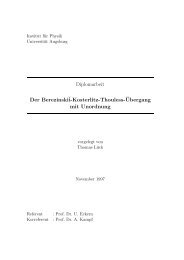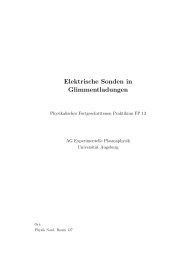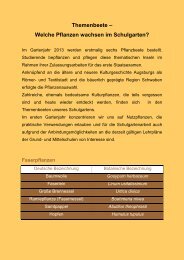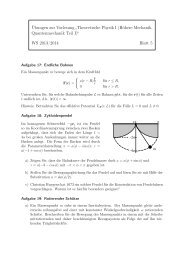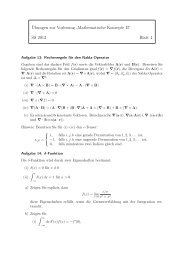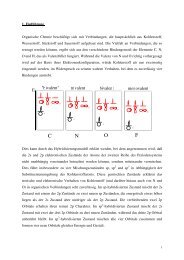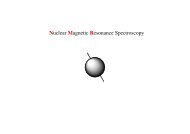PhD Thesis - Universität Augsburg
PhD Thesis - Universität Augsburg
PhD Thesis - Universität Augsburg
Create successful ePaper yourself
Turn your PDF publications into a flip-book with our unique Google optimized e-Paper software.
28 2. Density-Matrix Renormalization Group<br />
The states of the considered structure had appeared in the literature in many different<br />
contexts and under different names before the invention of DMRG. The simplest case of<br />
(2.14), corresponding to a homogeneous state with the same matrices for all sites, was first<br />
considered in the eighties [60, 61] and occured as a ground state of certain spin chains with<br />
competing interactions [141]. The best-known example is the spin-one chain with bilinear<br />
and biquadratic interactions and a certain ratio of the couplings, where the valence-bond<br />
ground state [2, 3] can be written in this form using (2 × 2) matrices.<br />
In this thesis, we focus only on the case of open boundary condition (MPS (2.11)).<br />
The systems with periodic boundaries can be studied within these states too, however the<br />
effective dimensions a j tend to the square of that required for open boundary conditions<br />
[150].<br />
2.2.1 MPS, Blocks, and a Superblock<br />
There is another way of expressing c(s) in MPS. Instead of starting from the site 1 and<br />
growing the system by subsequent adding from the right the sites 2, 3, and so on (like<br />
in the previous subsection), one can start from the site L and add from the left the sites<br />
L − 1, L − 2, . . . , 1.<br />
Similar to the procedure outlined in the previous subsection we start with some orthonormal<br />
basis {|β L 〉} in H L and express it in terms of |s L 〉<br />
where<br />
|β L 〉 =<br />
〈β ′ L|β L 〉 = δ β ′<br />
L ,β L<br />
⇐⇒<br />
d L<br />
∑<br />
s L =1<br />
B L (s L ) βL |s L 〉 , (2.15)<br />
d L<br />
∑<br />
s L =1<br />
B ∗ L(s L ) β ′<br />
L<br />
B L (s L ) βL<br />
= δ β ′<br />
L ,β L<br />
. (2.16)<br />
After adding from the left first the (L − 1)-th site, then the (L − 2)-th, and so on,<br />
at step L − k = j we can write a basis of H R(j) ⊂ H j ⊗ H R(j+1) ⊂ ⊗ L<br />
i=j H i in terms of<br />
|s j 〉 ⊗ |β j+1 〉 as<br />
with<br />
b j+1<br />
∑<br />
d j<br />
∑<br />
β j+1 =1 s j =1<br />
|β j 〉 =<br />
d j<br />
∑<br />
b j+1<br />
∑<br />
s j =1 β j+1 =1<br />
B j (s j ) βj ,β j+1<br />
|s j 〉 ⊗ |β j+1 〉 , (2.17)<br />
B ∗ j (s L−1) βj ,β j+1<br />
B L−1 (s L−1 ) βj ,β j+1<br />
= δ β ′<br />
j ,β j<br />
= 〈β ′ j |β j 〉 . (2.18)<br />
Substituting |β j 〉 from the previous steps in (2.17)<br />
∑<br />
|β j 〉 = [B j (s j )B j+1 (s j+1 ) · · ·B L (s L )] βj |s j 〉 ⊗ |s j+1 〉 ⊗ · · · ⊗ |s L 〉 , (2.19)<br />
s j ,s j+1 ,...,s L



